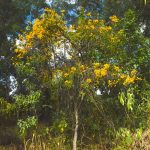TREE LIFE
June 2019
MASHONALAND CALENDAR
Saturday 1st June: Botanic Garden walk. Meet in the car park at 8.30am. Hope to see you there, this walk should last about an hour and a half.
Sunday 16th June 2019: Ewanrigg Botanical Gardens. Directions: Take the Enterprise Road out of Harare and turn left onto the Shamva Road just after the tollgate. After 15.4 kms, at the signpost turn right onto Harold Christian Road. Ewanrigg Botanical Garden is on the right, 2.4 kms down this dirt road. After paying an entry fee, turn right and park on the right hand side at the far end of the car park. We will begin botanising at 9:45am. To share transport, meet at CABS at 8:40am for a 8:50am start.
Saturday 22nd June 2019: Greystone Park Nature Reserve. We meet at 2.30pm.
CHAIRMAN’S REPORT 2018-19
I have pleasure in presenting my fourth annual Chairman’s report of the Tree Society covering the year 1 April 2018 to 31 March 2019.
The regular Tree Society series of monthly outings continued and we managed to organise eight 3rd Sunday outings although two of them were weekend outings. It has become increasingly more difficult to organise outings to private gardens for the Saturday afternoon outings. If you have a suitable garden or know of a friend who has one and doesn’t mind us coming along, kindly let your committee know. The supply of tea and buns by the host is not mandatory but nonetheless very welcome! Ten of the 4th Saturday afternoon walks also took place during the year. We also have a regular tree walk on the first Saturday of the month at the National Botanical Gardens.
Weekend Trips: In addition to the regular monthly outings, there was a week end trip, to Hippo Pools from 21st to 23rd April 2018. On this trip we enjoyed the renovated accommodation and had some excellent botanising. Meg and Mark were our leaders for the weekend – many thanks.
We then had another trip to Seldomseen in the Bvumba from 16th to 19th November. Twelve Harare members joined up with the Easterners for a weekend of botanizing. Unfortunately we had some very late cancellations by some of our members due to personal issues. I thank Mark & Meg for once again leading us. The vegetation in the Bvumba is very different to that found around Harare and we would have been lost without you, so many thanks.
Thanks to Mary for organising these trips, which are very enjoyable and if you have never been on one of them, you are seriously missing out!
Tree Leaders: I would like to thank all those who have led in any of our many outings – Saturday mornings & afternoons and Sunday mornings as well as on weekend outings. Without you, we wouldn’t have meaningful outings, especially outings away from Harare where the trees are not so well known to the majority of members.
Tree Life: Sufficient material is not always available as there appears to be a reluctance by some members to send in articles – this results in some rather “thin” Tree Lifes with very few pages. If you think your English is not up to it, don’t worry we can always fix it – it’s your idea of how an outing went that we want. Fortunately, Mary has been able to come up with interesting material from past newsletters to “beef up” the newsletters.
Thanks to those who contributed write-ups on our outings and articles for Tree Life – in order of appearance: Barbara Dean; Isla Grundy; Mary Lovemore; Ann Sinclair; Tony Alegria; Barbara Kockett; Dick Petheram (Feb 1978); W.J. Ascough (Apr 1974); Anne Butler; Jan van Bel; Ryan Truscott; Meg Coates Palgrave; Alex Masterson; C.B. O’Neill (June 2016); Catherine Browne & William Bond (June 2011); Julie Stevenson; Mark Hyde; Olwen and Megan Hartung. Apologies to anyone I may have left out. In the last year I feel that Mary Lovemore and Jan van Bel made the most contributions – many thanks.
Bequest: In early November 2016, we were asked by Jono Waters to manage a bequest by the late Mrs. Lottie Gyde for the National Botanical Garden. Most of this money was spent on the water system to try to keep as many trees alive as possible. Unfortunately this did not work as the pipes in use leaked and the borehole pressure was totally insufficient – before a large pump took water from the lake and thus overcame the leaks in the pipes. Since then some of the remaining bequest has paid for the +- 600 tree labels used in the National Botanical Garden.
Finances: The financial position of the Society remains satisfactory. The accounts and balance sheet have been prepared and will be presented by Bill Clarke later on this morning. We are staying with the current subscriptions for the time being but, if things change drastically, we may have to revue them at committee level.
Tree Society Facebook group: Since last year the group membership has increased by another 190 and now stands at 3241 at the end of April. From the Facebook page we point to the website and vice versa.
Tree Society Web page: Last year I reported “At last, the new web page is under construction and will be available shortly”. Famous last words! First of all, we had to go through a learning curve!. We finally went live on 9th November last year when we had sufficient content to do so. During April 2019 we had 409 hits: The top ten being Zimbabwe 211, USA 73, UK 29, South Africa 17, Australia 13, China 9, Ireland 6, Portugal 3 and Canada 2. Since going live, till the end of April, we have had 1236 hits coming from many different countries. Presently Tree Lifes are being added to the website by Mary Lovemore and Jim Sinclair. Thanks ever so much to both of you for your time, that is many, many hours, to do this.
Capturing back numbers of Tree Life: This mammoth undertaking in re-typing Tree Life(s) from 1994 and earlier years was done by Mary Lovemore. As stated before Mary and Jim are now adding these newsletters to the website.
Herbarium fumigation: Fumigation of the National Herbarium was carried out twice in the last year by Fumigation Services.
Tree Labeling: Some of us have been involved in tree labeling in Greenwood Park, Haka Game Park, Ewanrigg, Lasting Impressions, Mukuvisi and National Botanic Garden. I would like to thank all those who have been involved in these projects. We still have, and I suppose we will always have a problem with identifying exotic trees, and if anyone can help, or knows someone who can help, please step forward.
Christmas Party: Fortunately we were once again able to go to Val d’Or for the Christmas Social last year. We were rained on but that didn’t dampen the spirit at all – we badly needed the rain. Two teams holding umbrellas went out in the rain on the scavenger hunt to get samples of the trees Bill had listed …. and they enjoyed it! After the scavenger hunt, Christmas fare was enjoyed and then we sat down to the serious matter of trying to answer quiz questions. I thank Bill Clarke for compiling and running what turned out to be a fun General Knowledge quiz. His Port and Amarula afterwards also went down a treat.
Membership: As at 31 December 2018, we had 107 members, comprising ordinary, external and honorary members.
Committee: Since the last AGM, there have been no changes. The current committee consists of the following nine people: Jim & Ann Sinclair, Isla Grundy, Bill Clarke, Teig Howson, Ryan Truscott, Mary Lovemore, Jan van Bel and myself. My sincere thanks go to the members of the Committee for their hard work and support. A big thank you to Mary, once again she has done the most work in the past year for the Society.
In conclusion …
The Society is in a strong position in terms of its finances and its membership. 2018-2019 was a successful and active year for the Society. Long may it continue.
-Tony Alegria
Botanic Gardens Walk Saturday, 4th May, 2019.
A beautiful sunny May morning greeted us for our walk with Tony leading the way to the Lowveld section of the garden. Also present were Jan, Dawn, Mark, Jim & Ann Sinclair, Peter & Barbara Dean and new faces Kevin, Linda and Ed O’Toole.
We first discussed the discrepancy of the two maps of the garden. The first one, in the car park is accurate but the map by the path to the lecture room is very old and peeling, not correct and should be taken down.
Our first tree was a young Acacia xanthophloea. When Tony had labeled this tree he had had to bend down to attach the label. The label is now at eye level, showing the huge rate of growth in a year. The local variety of A. xanthophloea has yellow flowers, but others, some planted on Harare’s streets, have white flowers and may have come from Kenya or further North. A rather sad, small tree growing by the path is Xanthocercis zambesiaca. Nyala berry, the leaves are stiff and small. In the Lowveld this tree grows into a large very beautiful tree, but it is not happy in the cooler temperatures of Harare.
We stopped to discuss 24 more trees in the Gardens, as follows:
Kigelia africana, the Sausage tree, has compound leaves with a large terminal leaflet. The leaves are rough, the flowers large and attractive in drooping sprays and the fruit hang down. It is large and weighs up to 10kgs. The flowers are pollinated by bats and the fruit is used for skin disorders.
Acacia mellifera, this occurs in NW Namibia in the semi desert ,as well as in some of the drier parts of Zimbabwe. The leaflets are relatively large.
Albizia anthelmintica, Worm-cure Albizia, has white flowers with fluffy heads usually produced before the leaves. The bark is used as a cure for tapeworms.
Cordia ovalis, Sandpaper Cordia, has very rough oval leaves and the fruit is ovoid and fleshy and orange red when mature.
Adansonia digitata, the Baobab. This tree has been decapitated at head height, but has some new leaves. The very young leaves are simple and as they get older they have three leaflets. Mature leaves are palmate with five leaflets.
We came across a very large specimen labeled Schotia brachypetala but doesn’t quite look right. Is this possibly a different species?
Amblygonocarpus andongensis, Scotsman’s Rattle. We found two large trees with the very distinctive four-sided pods, almost square in cross section. This species occurs in deep Kalahari sand in the NW corner and East of Zimbabwe.
Cladostemon kirkii is a small tree occurring in eastern Zimbabwe in low altitude, open woodland. The leaves are trifoliate with very long petioles.
The next tree was a beautiful large Ziziphus pubescens, unarmed and with large ovate leaves. The leaves are three veined from the base, as for all the species of Ziziphus. And next to that was Philenoptera violacea, the Rain tree. [This frost sensitive and drought resistant tree often has an interesting symbiotic relationship with a spittle bug or leaf hopper and it is this insect which causes the ‘rain’. The insect draws the tree sap by piercing the bark of the tree and sucking the sap at great speed with its mouthparts. The tree sap is a weak solution of sugars and salts and the insect has to consume a great deal in order to obtain sufficient nourishment, so it ejects almost pure water equally fast. This drips from the tree in sufficient quantities to form pools on the ground below, which the tree can use again to its advantage in drought conditions – Ed, source Flora of Zimbabwe].
Albizia versicolor, the Poison-pod Albizia. The leaflets are largest at the end of the leaf. The young pods can be very toxic to livestock, hence its name. On rare occasions, when a strong wind blows the pods to the ground before the rains, cattle will eat them when there is no green grass. We lost about 10 head of cattle one year when we farmed in Umboe.
Acacia nigrescens, the Knobthorn, with flower spikes and large knobs on the trunk. The young pods facing the sun will turn red.
Bolusanthus speciosus, the beautiful Tree wisteria.
Albizia harveyi has sickle shaped leaflets.
Artabotrys brachypetalus, a climber with distinctive curling flower stalks.
Spirostachys africana, the Tamboti tree, is a medium sized Lowveld tree. The leaves are light green and hairy, becoming brilliant yellow to red in the autumn. The milky latex is poisonous, used as a fish poison and on arrow heads. The wood is not suitable for fuel, it burns with a strange odour which becomes sickening and causes headaches and nausea. The smoke will taint food which is cooked on an open fire.
Erythrophleum africanum, the Ordeal tree, occurs on Kalahari sand and in riverine thickets. The leaves have three to four pairs of pinnae, each with 10 to 17 leaflets. They are soft and velvety to touch. The roots and leaves have poisonous properties.
Hexalobus monopetalus is a small tree occurring in low altitude bush on rocky outcrops. It has very attractive flowers which are velvety brown to red.
Rhus gueinzii, a thorny Rhus with flowers in spikes; Feretia aeruginescens. Pink Medlar; a species of Phyllanthus, the Potato bush; Kirkia acuminata just changing into its autumn leaves which are gold and red.
Our last trees were a group of Commiphora from E and SE tropical Africa. Commiphora merkeri has simple leaves with a distinctive bark with dark rings while Commiphora caerulea has a branched trunk that is smooth grey and knobly. We found a couple of points where two branches had met, they had fused together.
A fascinating and interesting morning. Many thanks to Tony, Mark and Jan for all their input and knowledge.
– Ann Sinclair
Outing to Chapungu Sculpture Park Saturday 27th May
We were invited to Chapungu Sculpture Park by the owners, Roy & Marcey Guthrie, to identify the trees within Doon Estate as they wanted to label them. Roy has been planting many trees there over the last thirty years but more often than not didn’t know what he was actually planting. The area we covered was mainly within the sculpture park and although we identified 52 species of trees, there are still quite a few more to look at. The first tree to be identified was Acacia galpinii and the second was a Bauhinia tomentosa and then we came to a row of three trees that looked similar but kind of different to each other. We came to the conclusion that they were actually the same species but which species?
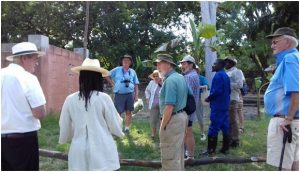
Welcome by Roy and Marcey Guthrie. Photo: Barbara Dean
We had our two gurus with us but they were kind of “stumped” as to the identity of these three trees. Meg Coates Palgrave thought they may be Ekebergia capensis but …… Mark Hyde took some samples to identify them later. He has since confirmed that Meg was correct – they are Ekebergia capensis. Besides Meg and Mark, present were Jim & Ann Sinclair, Peter & Barbara Dean, Ryan Truscott, Dawn Siemers, Jan van Bel, Ian Riddell and myself. We also had a new face in Colin Kuhuni. On this bright sunny Saturday afternoon, we had our hosts armed with the paper work and their workers equipped with labels, hammer and nails ready to label a tree and record the species as they were identified.
There were a few large Eucalyptus citriodora whose dry leaves smell strongly of citronella, however the common name is lemon-scented gum! Another large exotic tree was the Phytolacca dioica. Belhambra tree – one of which was growing on the steps of the amphitheatre. We did not label the Jacarandas or Syringa trees and didn’t know the tree that looked like an exotic Albizia with light green bark. Trees that were too small to label were Peltophorum africanum, Acokanthera oppositifolia and Tecomaria capensis with yellow flowers.
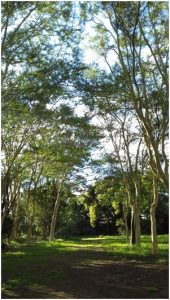
Cathedral-Acacia xanthophloeas Photo: Barbara Dean
Impressive large trees were Bridelia micrantha. Mitzeerie, Terminalia sericea. Silver clusterleaf, Celtis africana. White-stinkwood and an Erythrina abyssinica. Red-hot-poker coral-tree. On an island in the lawn were Dovyalis caffra. Kei apple, Gardenia volkensii. Woodland gardenia and Dombeya burgessiae. Pink wildpear. While not far off was a Acacia sieberiana with branches laden with pods drooping down to head height.
Towards the one side there was a large boulder with a variety of trees growing around it including Ficus burkei. Common wild fig, Gardenia ternifolia. Powder-bark gardenia, Sclerocarya birrea. Marula, Commiphora marlothii. Paper-bark corkwood, Lannea discolor. Live-long, Sterculia africana. African star-chestnut, Sterculia quinqueloba. Large-leaved star-chestnut, Trema orientalis, Pidgeonwood, Synadenium kirkii. Northern dead-man’s tree and some other trees we had already seen.
Before ending the outing and sitting down to refreshments kindly supplied by our hosts, we were taken to the Chapungu car park where Roy had planted an impressive number of Acacia xanthophloea (Fevertrees) some thirty years ago. Whilst enjoying the refreshments, Marcey told us what they were thinking about doing in the future in terms of trees.
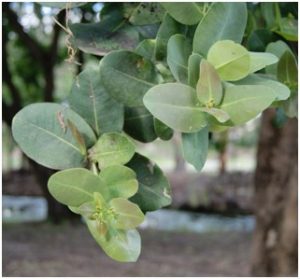
Syzygium cordatum Photo: Barbara Dean
Roy has created an indigenous nursery where he has been propagating many trees and has over twenty species of indigenous trees for sale. He hopes to encourage small scale farmers to plant the trees in the rural areas and would welcome any ideas from the Tree Society and the Zimbabwe Commercial Farmers Union to this end. Chapungu also hopes that through the labelling of all the trees on the property, school children are encouraged to visit through school tours to identify the trees and make their families and friends aware of the importance of indigenous trees in reforestation and conservation. In particular, Roy would like the general public to be aware of the possible commercial value of certain trees which may be able to be grown such as the Fever Tree ( Acacia xanthophloea ) which if spaced correctly and trimmed regularly to grow into a tall tree could be a substitute for imported pine that is now locally grown. We are all aware of the success of our Mukwa and Mahogany trees but there are a number of others which could be propagated for their industrial, medicinal and conservational uses. Chapungu will be involved in the experimentation of these varieties. Roy can be reached at 0774894027 or rgatchap@aol.com
Some other trees identified and not listed above: Combretum erythrophyllum. River combretum; Faidherbia albida. Ana tree; Ficus sur. Broom-cluster fig; Ficus lutea. Large-leaved fig; Acacia polyacantha. White-stem thorn; Searsia longipes. Large-leaved crowberry; Rauvolfia caffra. Quinine tree; Acacia abyssinica. Nyanga flat-top; Khaya anthotheca. Red mahogany; Kigelia africana. Sausage-tree; Cordia africana. Large-leaved saucerberry; Clerodendrum eriophyllum. Hairy tinderwood; Podocarpus henkelii, Henkel’s yellowwood; Syzygium cordatum. Waterberry; Salix babylonica, Weeping willow; Albizia gummifera. Smooth-bark flat-crown; Albizia schimperiana. Forest long-pod albizia; Bolusanthus speciosus. Tree wisteria; Acacia polyacantha and Acacia karroo.
We had a most enjoyable afternoon thanks to our hosts, but we still have a lot more trees to identify for the labelling exercise to be completed, so we are thinking of going back to this venue in the near future.
-Tony Alegria
TREE OF THE MONTH — TRICHILIA DREGEANA
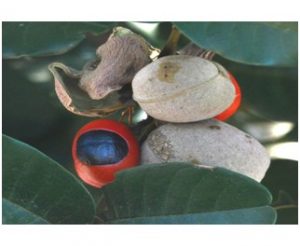
Trichilia dregeana seed Photo: Ryan Truscott
This month’s candidate for Tree of the Month could help you to have a better night’s sleep. It’s the Forest Natal Mahogany, Trichilia dregeana.
The tree hails from the evergreen forests of eastern Zimbabwe, though it appears to be widely grown in Harare, both in gardens and as a street tree.
Its geographical range is smaller than that of T. emetica, the Natal mahogany, which grows at lower altitudes, including the Zambezi Valley.One would have thought a lowveld species would be more suited to arid street conditions. Nevertheless, I came across a Forest Natal mahogany doing well and in fruit this month in Mount Pleasant’s Bond Street car park.
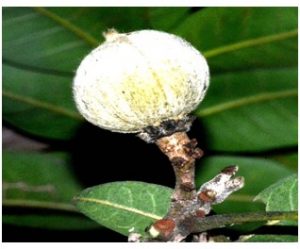
Trichilia dregeana fruit. Photo: Ryan Truscott
The cream-coloured capsules were cracking open to reveal their vivid orange and black seeds staring at me with that “vacant expression of a doll’s eyes”, as the Trees of Southern Africa puts it.
Meg Coates Palgrave, local botanist and Tree Society “guru” says she’s not surprised that most of the mahogany trees around Harare are the forest variety.
“I don’t know how it happened but the first ones were planted in the belief that they were the Natal mahogany,” she said.
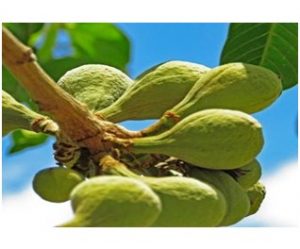
Trichilia emetica fruit. Photo: Ryan Truscott
She gave me some tips on telling the two species apart. The easiest way is to take a look at the fruit, if there are any. The fruit of T. emetica have a “stipe” or neck, connecting the base of the capsule to the stem. The fruit of T. dregeana are just round capsules on short stems.
The trees produce fruit at different times of the year: T. emetica finishes fruiting by March, T. dregeana carries on into May.
But what happens when the tree has no fruit? Last September, as I sat in the welcome shade of a Forest Mahogany in an Avondale garden to celebrate my father’s 80th birthday, I confidently and erroneously declared the tree to be T. emetica.
Solving the puzzle comes down to the tree’s “ID card” — the leaf. Yes, both species have similar compound leaves, with up to five pairs of opposite leaflets and a terminal one. But there are some subtle differences.
According to Meg, there’s the shape of the leaflets. Those of the Natal mahogany are “more or less” elliptic (broad in the middle, narrower at the ends); those of the Forest Natal mahogany obovate (broader at the top).
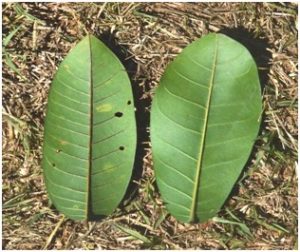
Leaves of T.dregeana and T.emetica. T.emetica on the left. Photo: Ryan Truscott
Then look at the undersurface of each leaflet, says Meg. You’ll notice some prominent pairs of lateral veins. In the Forest Natal mahogany, these should number between eight and 12; in the Natal mahogany, there should be MORE than 12.
I decided to put Meg’s leaf ID tip to the test, and drove to the National Botanic Garden. There, I knew from our society walk in April, the two species grow side by side near the herbarium.
As it was a Wednesday morning I had the garden to myself. I picked a leaflet from each tree, laid them on the grass and noticed the difference was as clear as the blue winter sky.
I asked Meg if she had a final word on these two trees.
“People always want to know the uses,” she said. “My favourite is: ‘The leaves are said to induce sleep when placed under the pillow at night’.”
Actually, I’ll sleep better now simply knowing I can tell them apart.
-Ryan Truscott
Annual Subs are $10 per family per year (due in April) and can be deposited in the Society’s CABS account – Acc. No: 1002549477. Acc. name: W.R.Clarke – Tree Society.
The subscriptions are now overdue. If you have not paid, please settle, soonest.
TONY ALEGRIA CHAIRMAN



